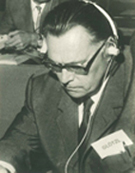Intelligent Data from Below
for Innovative Projects from Above
The Evolution of Structural Engineering
For more than 60 years, GLÖTZL Structural Engineering has been in an intensive dialogue with everything moving beneath the earth’s surface. Across all continents, their technical instrumentation serves the stability monitoring of dams, tunnels, bridges, mines, or foundations. Today, GLÖTZL is among the world’s leading experts in structural engineering. Over three generations, the company’s development can be divided into three epochs: The Pioneer Era, the Age of Inventions, and the Era of Expansion.
Pioneer Era in the 1950s and 60s
Franz Xaver Glötzl was a man of action. The company’s founder encountered questions during his work at the University of Karlsruhe in the field of civil engineering that theoretical answers alone couldn’t satisfy. He sought practical solutions. With the invention of the first flat hydraulic pressure pad, he not only laid the foundation of GLÖTZL but also made pioneering contributions to structural engineering.
The surface pressure gauge can measure stresses at any point in concrete. Simultaneously, it also determines other physical quantities in structures. The insights gained confirmed theory in practice: The statics of the structure finally found a reliable verification.
The invention had revolutionary effects on conventional tunnel construction. Initially, iron grid reinforcements were attached to the raw tunnel wall, followed by a shotcrete shell. Often, there was uncertainty about the stress conditions in the shells. With the invention of the surface pressure gauge, this became possible.
Before pouring concrete, GLÖTZL’s instruments were attached at various horizons. They simultaneously recorded the pressure load on the tunnel and the stress in the concrete. For the first time, the dimension of a tunnel shell could be determined in advance, and corrective measures, such as material savings, could be implemented. This insight propelled modern tunnel construction: the ability to precisely dimension tunnel shells, known as “Tübinge,” led to prefabrication in the factory. Today, the Tübinge are used in a conveyor belt-like manner following mechanical tunnel drilling.
Franz Xaver Glötzl revolutionized not only tunnel construction with his invention but also provided groundbreaking insights for today’s applied construction physics and static basics for modern civil engineering.
The Age of Inventions – The 70s and 80s
Naturally, GLÖTZL and its invention did not go unnoticed. Soon, imitators brought copied versions to the market. GLÖTZL’s response was a flood of new products and product developments. Within a few years, anchor force sensors, pore water pressure transducers, inclinometers, extensometers, stress sensors, borehole sensors – a product portfolio that continues to set standards in structural engineering – were developed in Rheinstetten near Karlsruhe. The dynamic expansion of the product range opened the door to new projects. Major transportation planning projects, such as the construction of the Paris Metro in 1974 or the ICE route from Munich to Kassel in 1978, were realized using GLÖTZL instrumentation. Another highlight was the significant participation in stability tests and planning for the building foundations of the Frankfurt Trade Fair Tower.
Expansion in the 90s
Participation in the construction of the Gorleben nuclear repository in 1992 marked a turning point in the company’s development and entry into large-scale concepts. New questions arose: “How does the mountain react under the influence of mining activities and years after their completion?” The full range of geotechnical investigations was deployed. Official standards for such structures demanded strict evidence collection. As a result, meticulous planning, complex coordination of measurement processes, and long-term documentation were indispensable.
Arriving in the Present – Intelligent Products and Optimized Evaluation
With digitization, the first step into the new millennium was taken. The devices were equipped with intelligent digital sensors, capable of independent calculation, compensation, and even self-monitoring. The system includes measuring systems and data loggers. Automatic conversion into various units, indication of real and raw values make results transparent, and complex measurement processes easy to understand.
The evaluation of measurement results is always the highlight of the process chain. It takes place in the engineering office. However, until the measurement results reach the engineer, they usually travel long distances. On-site, the data is collected, then delivered from office to office, where it is read, processed, and ultimately evaluated. Here too, GLÖTZL is already one step ahead: the evaluations are provided to users online. All decision criteria are predefined and programmed. Manual data retrieval is eliminated. Instead, several work steps are skipped, project workflows are accelerated, and safety standards are improved. The engineer can fully focus on further tasks and confidently await meaningful results.

